Kyoto Art Museums and Galleries: 15 Must-Visit Facilities

Kyoto boasts a vibrant art scene where contemporary art and traditional crafts stimulate each other. We introduce 15 of the best art museums and galleries in Kyoto that provide unforgettable encounters with Japanese art.
Renowned as a hub of artistic expression, Kyoto boasts a vibrant art scene that blends avant-garde creativity with time-honored traditions. In this city, contemporary art and traditional culture harmonize seamlessly, often converging within a single venue.
What sets Kyoto apart is that art is inseparable from crafts such as ceramics and lacquerware, which have played an essential role in Japanese arts such as the tea ceremony.
We introduce 15 art museums in Kyoto where you can feel the pulse of the city's ever-changing cultural landscape.
Kyoto Art Museums
1. Kyoto City KYOCERA Museum of Art
2. Fukuda Art Museum
3. Kahitsukan: Kyoto Museum of Contemporary Art
4. The National Museum of Modern Art, Kyoto
5. Kyoto National Museum
6. Hosomi Museum
7. Museum of Oribe Furuta
8. Nomura Art Museum
9. Asahi Beer Oyamazaki Villa Museum of Art
10. Museum EKI Kyoto
11. Kyoto International Manga Museum
12. Kyoto Museum of Crafts and Design
13. Gion Kagai Art Museum
14. Kyoto Confectionery Museum
15. Art Gallery at Kyoto Okazaki TSUTAYA BOOKS
1. Kyoto City KYOCERA Museum of Art

Photo by Pixta
The Kyoto City KYOCERA Museum of Art is one of the leading institutions in Kyoto's art scene. Opened in 1933, the main museum building is one of the oldest art structures in Japan. After undergoing major renovations in 2019, the building incorporates retro Western architectural elements combined with contemporary architecture. The museum comprises several other galleries and buildings.
The special exhibitions at Kyoto City KYOCERA Museum of Art focus on art from Kyoto and worldwide. These exhibitions are excellently curated and attract many visitors. Highlights of 2024 include The Cubist Revolution - An Exhibition from the Collection of the Centre Pompidou, Paris and the Takashi Murakami Mononoke Kyoto exhibition.
Visit the Collection Room to see art from the museum's collection, which comprises around 4,400 pieces of Kyoto art from various eras and genres. This collection embodies the evolution of Kyoto's art scene, where tradition and innovation intersect. The art forms represented include Japanese painting, Western painting, sculpture, prints, crafts, and calligraphy.

Photo by Pixta
The Kyoto City KYOCERA Museum of Art is located near the Heian Jingu Shrine and Okazaki Park, a location famous as a cherry blossom viewing spot. At the Museum Cafe ENFUSE, visitors can enjoy Kyoto desserts with fresh roasted coffee or craft alcoholic beverages with a view of the Lake Biwa Canal.
Hotels near Kyoto City KYOCERA Museum of Art
↑ Return to the top of article.
2. Fukuda Art Museum

Picture courtesy of Wabunka
Located in Arashiyama near the iconic Togetsukyo Bridge, the Fukuda Art Museum was opened in 2019 and swiftly made a mark in Kyoto, garnering recognition locally and internationally for its stunning architecture and exquisite art collection.
The museum's design harmoniously merges traditional Kyomachiya townhouse motifs with contemporary Japanese aesthetics, seamlessly blending into Arashiyama's beautiful natural surroundings.

Picture courtesy of Wabunka
The Fukuda Art Museum has a collection of approximately 2,000 works by Japanese painters from the Edo period (1603-1868) to the modern era, including rare works that have seldom been shown to the public. Though the works are not on permanent display, they are showcased during the four yearly special exhibitions.
Visit this museum to see works by famous Japanese painters such as Ito Jakuchu or Yokoyama Taikan. The facility boasts one of the largest collections of works by Takehisa Yumeji, known as the author of bijinga, portraits of beautiful women.
After your visit, you can unwind at the relaxing museum cafe with delicious desserts, light snacks, and drinks.
The activity booking site Wabunka offers an exclusive guided tour of the Fukuda Art Museum, which allows participants to learn inside stories about the art pieces on display from a museum curator. Join this tour for a deeper encounter with Kyoto's art scene!
Hotels near Fukuda Art Museum Saga Arashiyama
↑ Return to the top of article.
3. Kahitsukan: Kyoto Museum of Contemporary Art

The Kahitsukan Kyoto Museum of Contemporary Art is located in Gion. Established in 1981, this museum showcases modern and contemporary art that defies preconceived concepts.
The works of Japanese-style painter Kagaku Murakami (1888-1939), oil painter Kaoru Yamaguchi (1907-1968), and calligraphy, painting, and pottery artist Rosanjin Kitaoji (1883-1959) represent the core of the museum collection. Their work and aesthetics represent a bridge between Japanese traditional art and contemporary art that challenges the viewer to think freely.
Special exhibitions are held every spring and autumn. On the fifth floor is a tea ceremony room and the Sun Garden, a green space that receives direct sunlight, allowing visitors to feel the connection between art and nature.
Kahitsukan Kyoto Museum of Contemporary Art
Address: Kyoto, Higashiyama Ward, Gionmachi Kitagawa 271 Map
Hours: 10:00 - 18:00 *closed on Mondays
Website: http://www.kahitsukan.or.jp/frame_e.html
↑ Return to the top of article.
4. The National Museum of Modern Art, Kyoto

Photo by Pixta
The National Museum of Modern Art, Kyoto, or MoMAK, is a national institution dedicated to collecting and safeguarding artwork and associated reference materials from the twentieth century, originating from Japan and various global regions.
It places a specific focus on artists and artistic movements in Kyoto and the Kansai area of Japan, including the notable Japanese-style paintings of the Kyoto School. The museum also provides a comprehensive overview of Japanese modern art and craft movements, alongside a diverse collection of works spanning various genres from around the world.
Furthermore, MoMAK showcases five special and traveling exhibitions annually, alongside regularly rotating works in the Collection Gallery about five times per year. See glimpses of the MoMAK Collection.
The National Museum of Modern Art, Kyoto
Address: Kyoto, Sakyo ward, 26-1 Okazaki Enshojicho 26-1 Map
Hours: 10:00 - 18:00 *closed on Mondays
Website: https://www.momak.go.jp/English/
↑ Return to the top of article.
5. Kyoto National Museum

Photo by Pixta
The Kyoto National Museum is one of the first imperial museums established during the Meiji period (1868 - 1912), along with the Tokyo National Museum and the Nara National Museum. The first exhibition was held in 1897.
An independent institution since 2001, the facility has a Conservation Center for Cultural Properties and is actively involved in the preservation and research of historical artifacts and tangible national assets. This makes it the ideal place to see precious Japanese art objects that have withstood centuries.
The collection of the Kyoto National Museum includes masterpieces from all the fields of Japanese artistic expression, from Buddhist art to illustrated handscrolls, medieval painting, calligraphy, sculpture, ceramics, lacquerware, textiles and costumes, and much more.
If you want to gain a perspective on how Japanese art and crafts evolved throughout the centuries, the Kyoto National Museum is the place to go.
Kyoto National Museum
Address: Kyoto, Higashiyama Ward, Chayacho 527 Map
Hours: 9:30 - 17:00 *closed on Mondays
Website: https://www.kyohaku.go.jp/eng/
↑ Return to the top of article.
6. Hosomi Museum

Picture courtesy of PR Times
The Hosomi Museum was established in 1998 and hosts exhibitions of exquisite artifacts from the art collection of the Hosomi family.
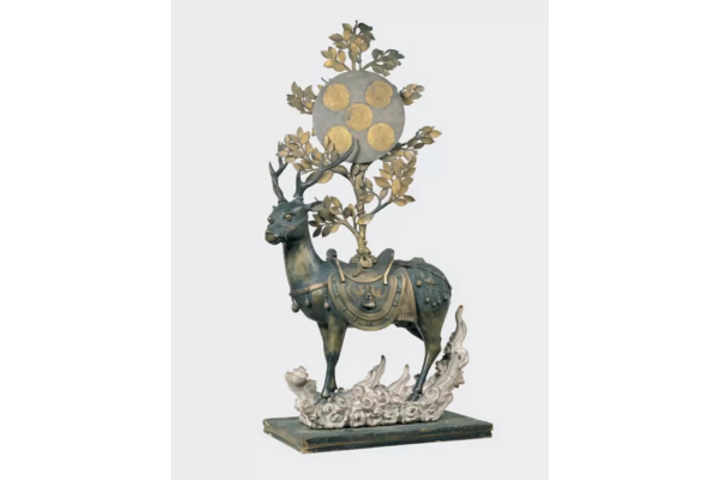
Important Cultural Property "Gold and Bronze Deity of Kasuga Shrine," Nanbokucho period (1336-1392), Hosomi Museum Collection. Picture courtesy of PR Times
The collection comprises around one thousand works of art from all the major periods in Japan's history, including Buddhist and Shinto art from the Heian (794-1185) and Kamakura (1185-1333) periods, Muromachi-period (1333-1572) ink painting, lacquerware and tea ceremony kettles, Momoyama (1573-1600) ceramics, as well as Edo-period (1603-1868) paintings by the Rimpa school and Ito Jakuchu.
True to its legacy, the Hosomi Museum has a tea ceremony room that is open to the public; this space is also regularly used for formal tea ceremony events. The elegant cafe of the museum is perfect to unwind after your visit. The Artcube Shop within the museum handles beautiful items with Japanese design.
The Hosomi Museum is located in the Okazaki area in eastern Kyoto, which is also home to the Kyoto City KYOCERA Museum of Art and other galleries, and is thus considered the "cultural area" of Kyoto.
Hosomi Museum
Address: Kyoto, Sakyo Ward, Okazaki Saishojicho 6-3 Map
Hours: 10:00 - 17:00 *closed on Mondays
Website: https://www.emuseum.or.jp/eng/index.html
↑ Return to the top of article.
7. The Museum of Furuta Oribe

Example of an Oribe-style container (*for illustration purposes only). Photo by Pixta
Furuta Oribe (1543 - 1615) was one of the seven disciples of tea master Sen no Rikyu and served himself as the tea ceremony teacher of the lords of the time, including shogun Tokugawa Ieyasu.
Oribe is known for preferring tea bowls with strong individuality, standing out through irregular shapes and unusual motifs. He was involved himself in producing tea bowls together with artisans of Mino, Karatsu, and Bizen pottery, as well as other tea utensils, architecture, and gardens.
The Museum of Furuta Oribe opened in 2014 and provides an introduction to the world of Oribe-style tea utensils, without which the tea ceremony as we know it today would not be the same. The museum is located near the Kyoto Botanical Gardens.
The Museum of Furuta Oribe
Address: Kyoto, Kita ward, Kamigamo Sakurai-cho 107-2, B1
Access: 3-minute walk from Kitayama Station (exit 4) on the Kyoto Subway Karasuma Line.
Hours: 9:30 to 17:00 (*closed on Monday, or Tuesday if Monday is a national holiday)
Official website: http://www.furutaoribe-museum.com/about-e.html
↑ Return to the top of article.
8. Nomura Art Museum
The Nomura Art Museum hosts two exhibitions every year in spring and autumn displaying items from the art collection established by Nomura Tokushichi (1878 - 1945), also known as Tokuan, the second-generation head of the institution now known as Nomura Holdings.
Tokuan was a dedicated tea ceremony and Noh theater practitioner. His collection comprises invaluable tea utensils, Noh masks and costumes, calligraphy works, and many other precious artifacts.
The museum has an exquisite tea ceremony room called Chouken ("The eaves under which we listen to the sound of the rain"), which regularly hosts formal tea ceremony events.
If you're in Kyoto in spring or autumn, do not miss out on an encounter with the essence of Japanese culture at the Nomura Art Museum.
Nomura Art Museum
Address: Kyoto, Sakyo ward, Nanzenji Shimokawaracho 61 Map
Hours: 11:00 - 16:30 (*closed on Monday, or Tuesday if Monday is a national holiday)
*Please note that the museum only operates during its two annual exhibitions from early March to early June and from early September to early December.
Website: https://nomura-museum.or.jp/publics/index/16/#block157
↑ Return to the top of article.
9. Asahi Beer Oyamazaki Villa Museum of Art

The Asahi Beer Oyamazaki Villa Museum of Art, established in 1996, is a venue that regularly showcases modern Japanese and Western art through exhibitions. Originally constructed in the 1920s as a personal weekend retreat by the influential businessman Shotaro Kaga (1888-1954), the Oyamazaki Villa embodies Kaga's admiration for British culture and his deep connection to nature.
Curated from the art collection of Tamesaburo Yamamoto (1893-1966), the inaugural president of Asahi Breweries and a close contemporary and patron of the Mingei art movement (*1) alongside Kaga, the museum's exhibitions provide a glimpse into a rich cultural legacy.

The Western art collection, featuring notable pieces by Monet, is housed in the Subterranean Jewel Box, an annex artfully designed by the celebrated architect Tadao Ando. This structure seamlessly blends with the villa's natural environs, creating an immersive experience that enhances the scenic beauty of the surroundings.
*1 The Mingei movement, started in the mid-1920s, promoted the beauty of Japanese folk crafts.
Hotels near Asahi Beer Oyamazaki Villa Museum
↑ Return to the top of article.
10. Museum EKi KYOTO
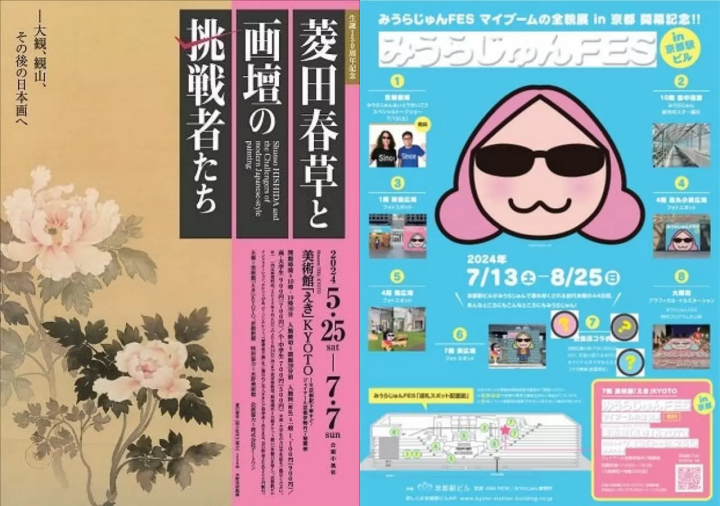
Pictures courtesy of PR Times
Museum EKi KYOTO is located on the 7th floor of the JR Kyoto Isetan department store within Kyoto Station. The facility opened in 1997 as a hub for cultural interaction, creation, and promotion.
Museum EKi KYOTO hosts exhibitions of various art genres such as painting, photography, picture books, crafts, animation, fashion, and others. With expertly curated, engaging exhibitions, it aims to be a museum that is beloved and familiar to everyone.
Showcasing the eclectic style adopted by the museum, the 2024 events include an exhibition dedicated to early 20th-century Nihonga painting and a summer exhibition featuring the work of contemporary artist Miura Jun.
Museum EKi KYOTO brings art closer to everyday life and is the perfect place to stop by for a casual encounter with Japanese art.
Museum EKi KYOTO
Address: Kyoto Station Building, JR Kyoto Isetan department store 7F
Hours: 10:00 - 19:30
Website: https://kyoto.wjr-isetan.co.jp/museum/index.html
↑ Return to the top of article.
11. Kyoto International Manga Museum

Photo by Pixta
Established through a collaborative effort between Kyoto City and Kyoto Seika University, the Kyoto International Manga Museum is home to a diverse collection of 300,000 manga materials.
The museum showcases an array of treasures ranging from ukiyo-e prints dating back to the Edo Period (1603-1868) to magazines spanning the Meiji (1868-1912), Taisho (1912-1926), and early Showa (1926-1989) eras. Additionally, the collection includes post-World War II rental books, popular contemporary manga series, and even comic books from around the globe.
Visitors not only have the opportunity to explore a wide selection of manga genres but can also engage in manga-themed workshops hosted within the museum's premises.
Kyoto International Manga Museum
Address: Kyoto, Nakagyo, Kinbukicho 452 Map
Hours: 10:00 - 17:00
Website: https://kyotomm.jp/en/
↑ Return to the top of article.
12. Kyoto Museum of Crafts and Design

Picture courtesy of PR Times
Since its opening in 1977, the Kyoto Museum of Crafts and Design has been promoting traditional crafts by introducing handicrafts rooted in Kyoto and their backgrounds.
Traditional crafts are deeply connected to Kyoto's culture, where unique arts such as tea ceremony, ikebana, and performing arts like Noh and Kyogen flourished. All these arts use objects, utensils, and costumes created by highly skilled specialized artisans. Their work has been shaping Japanese culture itself.
The museum underwent a renewal in 2020 and further enhanced its efforts to introduce the activities of contemporary artisans. Visit the Kyoto Museum of Crafts and Design for an encounter with authentic handicrafts that beautifully combine tradition with modern-day utility.
Kyoto Museum of Crafts and Design
Address: Kyoto, Sakyo Ward, Okazaki Seishojicho 9-1 B1F Miyako Messe Map
Hours: 10:00 - 18:00
Website: https://kmtc.jp/en/
↑ Return to the top of article.
13. Gion Kagai Art Museum
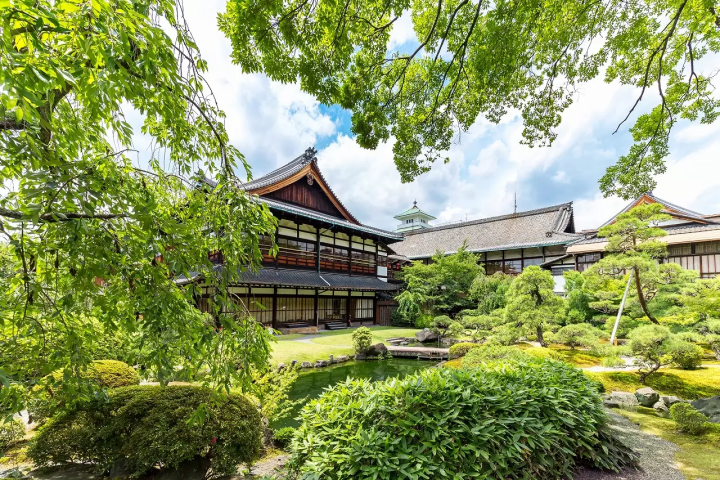
Photo by Pixta
Opened in May 2024, the Gion Kagai Art Museum is a venue dedicated to showcasing Kyoto's geisha culture. Situated in the heart of the Gion district, just opposite the iconic Yasaka Shrine, this museum features a permanent exhibition highlighting the rich heritage of Gion.
The facility occupies the Gion Kobu Kaburenjo, the main venue of the famous Miyako Odori, an annual event featuring dance performances by geisha entertainers. The history of this very special Kyoto event goes back to 1872.
Museum visitors have the unique chance to take photos with geisha and maiko and watch enchanting traditional dance performances.
Hotels near Gion Kagai Art Museum
↑ Return to the top of article.
14. Kyoto Confectionery Museum

The Kyoto Confectionery Museum opened in 1978 as a facility showcasing the history and craft of traditional Japanese confectionery.
Visitors can see exhibits of historical documents and utensils used by artisans to make intricate confections, as well as togei gashi, or ornamental candy sculptures crafted to look like real flowers and trees!

Admission to the museum is free, making it an affordable choice for all visitors. For a small fee, you can enjoy a piece of seasonal Kyoto confectionery with a bowl of matcha tea.
These beautiful sweet creations are made by Tawaraya Yoshitomi, a renowned confectionery adjacent to the museum. The shop sells high-quality Kyoto sweets, ideal for thoughtful gifts for family and friends.
Kyoto Confectionery Museum
Address: 331-2 Yanagizushicho, Kamigyo Ward, Kyoto Map
Hours: 10:00 - 17:00
Website: https://kyogashi.co.jp/shiryoukan/
↑ Return to the top of article.
15. Art Gallery at Kyoto Okazaki TSUTAYA BOOKS

Picture courtesy of PR Times
In a city rich in culture and international flair like Kyoto, the TSUTAYA BOOKS concierge has carefully curated a selection of books and goods themed around art and Japanese lifestyle.
Kyoto Okazaki TSUTAYA BOOKS is located in Okazaki, Kyoto's cultural district, and is adjacent to theaters, art museums, and Okazaki Park. This stylish cultural space allows visitors to enjoy coffee, read books, and enjoy exhibitions in its art and craft gallery.
The art gallery at Kyoto Okazaki TSUTAYA BOOKS regularly hosts exhibitions of contemporary art. Visit this location to get a glimpse into the latest developments in Japanese art, meet artists and their work, and even purchase works of art for your collection.
Kyoto Okazaki TSUTAYA BOOKS
Address: Kyoto City, Sakyo ward, Okazaki Saishoji-cho 13, Rohm Theatre Kyoto Park Plaza 1F Map
Hours: 8:00 - 20:00
Website: https://store.tsite.jp/kyoto-okazaki/ (Japanese)
↑ Return to the top of article.
Enjoy Art in Kyoto
Kyoto is a truly vibrant cultural city offering plenty of opportunities to enjoy art. It is one of the best places in Japan to see how traditional culture coexists with modern and contemporary art, and how all of Japan's artistic styles inspire and stimulate each other.
Held every year in October, Kyoto Experiment, one of Japan's prominent festivals showcasing visual arts and performing arts, is also an excellent means to feel the cultural pulse of the city.
We hope that the art museums and galleries featured above serve as your gateway to exploring Kyoto's exciting art scene.
Read also
Ramona, English content editor at MATCHA since 2016, has been practicing ikebana flower arrangement (Ikenobo School) and tea ceremony (Omote Senke) since 2012. She arrived in Japan in 2012 as a graduate student with a focus on Japanese literature and performing arts. As a travel editor and writer, Ramona has visited and documented 40 of Japan's prefectures with a focus on art, history, traditional Japanese crafts, and performing arts.





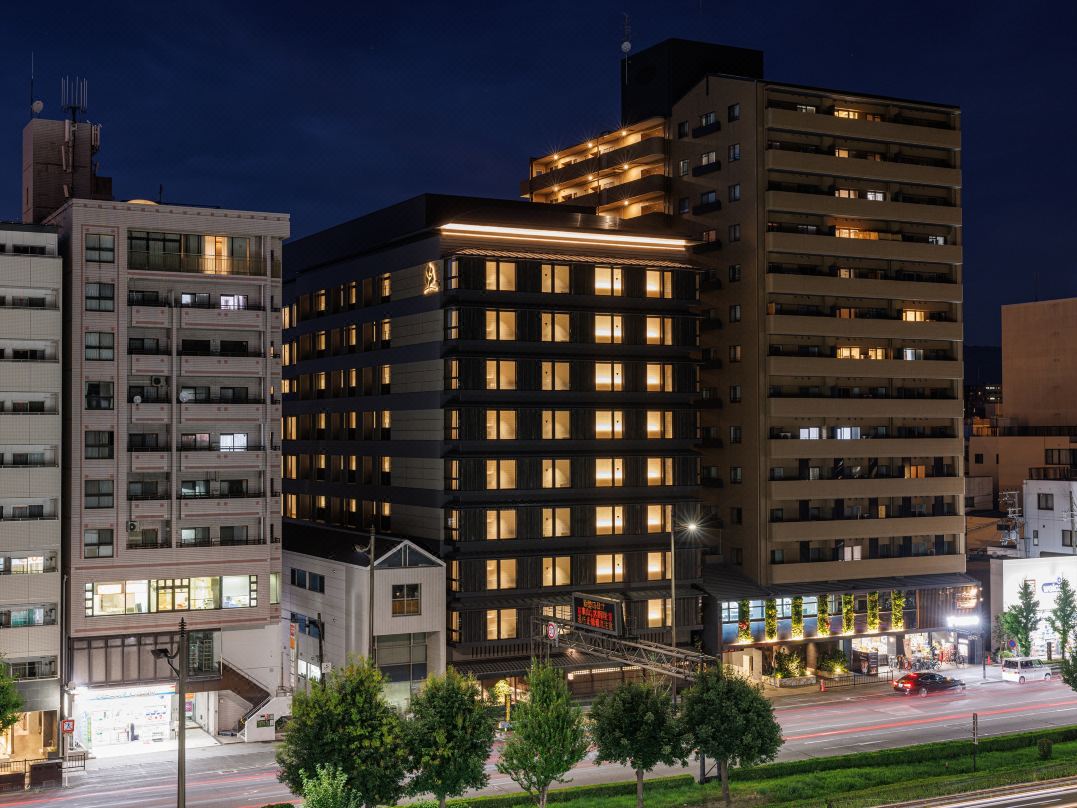













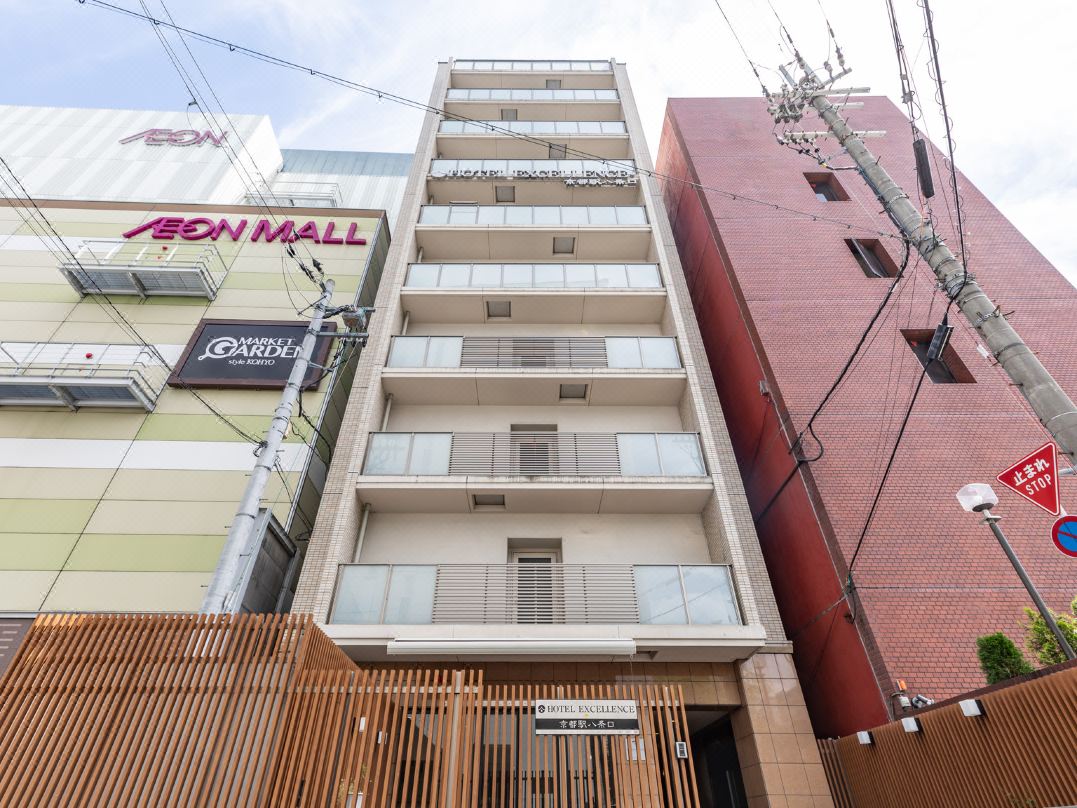

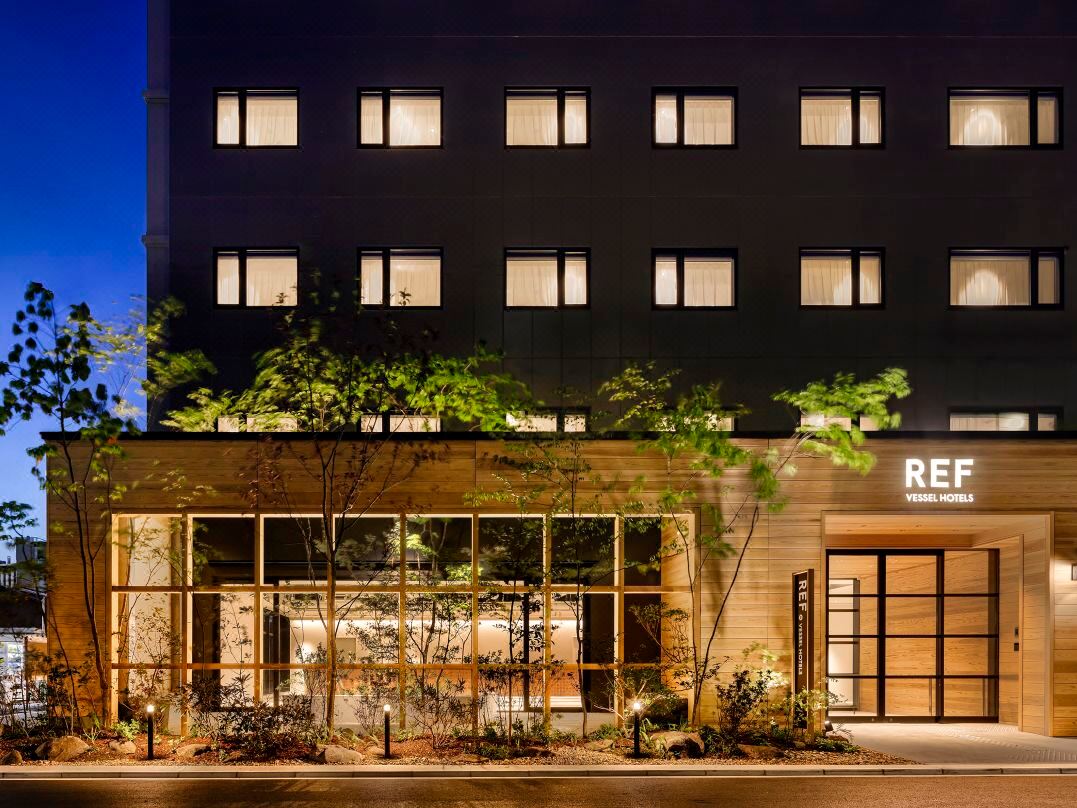

































![[Just a short distance from Nagoya] Popular Taiwanese YouTuber Alan tours Aichi, Tokoname!](https://resources.matcha-jp.com/resize/720x2000/2026/01/08-255181.webp)


